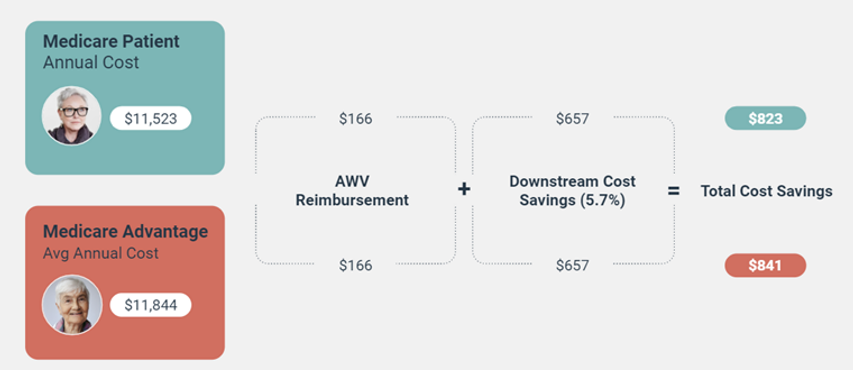Driving Annual Wellness Visits to Medicare-age patients can reduce the total cost of care while growing appointment volume, health outcomes, and downstream revenue.
You’ve done the math as a healthcare marketer. You know outreach campaigns for patient activation are a cost-effective way to increase revenue and to improve the patient experience. But where do you start? Which patient segments are the proverbial lowest hanging fruit?
One group — Medicare and Medicare Advantage (MA) recipients — stands out:
- They need healthcare more than most other groups
- Their rate of Medicare annual wellness visits (AWV) utilization is quite low
- The cost of AWVs for this group is usually completely covered
- The benefits to both the healthcare system and the patient are significant

Key Medicare Stats

A Huge Healthcare Gap for Medicare Annual Wellness Visits
Did you know only 25% of Medicare and Medicare Advantage (MA) recipients get an annual wellness visit? Yet nearly half (45%) of all Medicare beneficiaries have four or more chronic conditions, like high blood pressure, diabetes, or heart disease. The prevention, management, and treatment of those conditions are critical to their health outcomes. Your services can help improve their quality of life and their care journeys through appropriate downstream referrals while simultaneously helping your organization lower the total cost of care.
Patients with one chronic condition, let alone four, need to see a doctor, so why are they not showing up? Unfortunately, many Medicare and MA recipients don’t know they’re eligible for an initial preventive physical exam (IPPE) in their 65th year and an AWV every year after that.
Mindsets may be another barrier. If they feel fine, why go to the doctor? That mindset isn’t limited to people over 65, of course, but it’s one of a multitude of factors that make many people reluctant to schedule a primary care visit.
Benefits to the Patient
While patients who are younger and healthier may be able to shrug off an annual visit to the doctor, for older patients, these visits can be incredibly valuable. Primary care doctors and routine screenings can uncover concerns or risks that need further examination or treatment. Early detection can prevent disease progression as well as minimize expensive treatments that might be necessary if the condition goes unnoticed.
As just one example, according to a study cited by the CDC, if US adults with uncontrolled high blood pressure received care for it (using team-based care including a pharmacist), that knowledge and approach could prevent up to 91,900 heart attacks, 139,000 strokes, and 115,400 cardiovascular deaths over 5 years.
Benefits to the Healthcare System
For healthcare and service line marketers, AWVs are the gateway for driving patient volume across various services. By proactively reaching out to Medicare patients, marketers not only help influence patient outcomes, but they can also help the organization:
- Increase revenue
- Reduce total cost of care
- Improve patient satisfaction
- Drive higher quality scores
- Fulfill your mission and brand promise
For provider organizations, Medicare annual wellness visits represent an opportunity for downstream revenue from referrals as well as lower total cost of care over time. According to The American Journal of Managed Care, March 2019, “Patients who received an AWV in the index month experienced a 5.7% reduction in adjusted total healthcare costs over the ensuing 11 months.”

How to Increase Medicare Annual Wellness Visits
The case for increased outreach to Medicare and MA recipients for AWV is clear. But how do you get them to show up?
- Identify. Start by activating your patient population. Actium Health’s CENTARI™ uses your EHR data to identify not just those who are Medicare and MA recipients, but to also prioritize patients within that group who need care the most and are most likely to respond.
- Activate. Once you know who to reach, what do you communicate? Keep it focused by using an always-on campaign around preventive screenings and wellness. That’s what this audience needs the most.
In terms of the channel, for information that requires action (like scheduling an appointment), the key is to keep it simple and direct. Health-related communication preferences typically skew towards mobile communications where text messages have significantly higher engagement than emails. - Measure. Intelligent campaigns adjust outreach to capacity to deliver consistent, predictable patient volume to your service lines. In fact, you’ll have a direct line of sight from your always-on campaigns to the number of the appointments the campaign has driven. This translates directly to top line revenue and the ROI you deliver as a healthcare marketer.
The Triple Win of AWV for Medicare and MA Recipients
A health system can generate more than $800 in additional revenue per patient with increased Medicare annual wellness visits. With 44 million Americans currently enrolled in the Medicare program, healthcare systems have untapped opportunities to drive revenue, close care gaps, and improve health outcomes.
Read our case study about the value of increasing AWV.

Sources:
[1] Why Medicare Wants Providers Performing AWVs
[2] Centers for Medicare and Medicaid Services. National Health Expenditure Projections: Forecast Summary 2019-2028
[3] Congressional Budget Office, Medicare Baseline. March 2020
[4] Centers for Medicare and Medicaid Services, Program Statistics, 1965–2018

